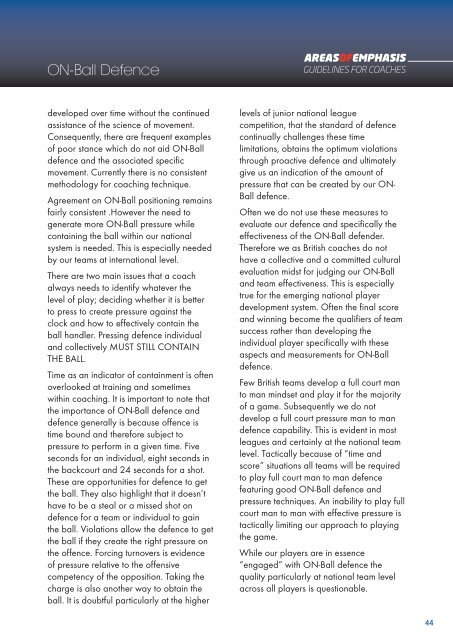You also want an ePaper? Increase the reach of your titles
YUMPU automatically turns print PDFs into web optimized ePapers that Google loves.
ON-Ball DefenceAREASOFEMPHASISGUIDELINES FOR COACHESdeveloped over time without the continuedassistance of the science of movement.Consequently, there are frequent examplesof poor stance which do not aid ON-Balldefence and the associated specificmovement. Currently there is no consistentmethodology for coaching technique.Agreement on ON-Ball positioning remainsfairly consistent .However the need togenerate more ON-Ball pressure whilecontaining the ball within our nationalsystem is needed. This is especially neededby our teams at international level.There are two main issues that a coachalways needs to identify whatever thelevel of play; deciding whether it is betterto press to create pressure against theclock and how to effectively contain theball handler. Pressing defence individualand collectively MUST STILL CONTAINTHE BALL.Time as an indicator of containment is oftenoverlooked at training and sometimeswithin coaching. It is important to note thatthe importance of ON-Ball defence anddefence generally is because offence istime bound and therefore subject topressure to perform in a given time. Fiveseconds for an individual, eight seconds inthe backcourt and 24 seconds for a shot.These are opportunities for defence to getthe ball. They also highlight that it doesn’thave to be a steal or a missed shot ondefence for a team or individual to gainthe ball. Violations allow the defence to getthe ball if they create the right pressure onthe offence. Forcing turnovers is evidenceof pressure relative to the offensivecompetency of the opposition. Taking thecharge is also another way to obtain theball. It is doubtful particularly at the higherlevels of junior national leaguecompetition, that the standard of defencecontinually challenges these timelimitations, obtains the optimum violationsthrough proactive defence and ultimatelygive us an indication of the amount ofpressure that can be created by our ON-Ball defence.Often we do not use these measures toevaluate our defence and specifically theeffectiveness of the ON-Ball defender.Therefore we as British coaches do nothave a collective and a committed culturalevaluation midst for judging our ON-Balland team effectiveness. This is especiallytrue for the emerging national playerdevelopment system. Often the final scoreand winning become the qualifiers of teamsuccess rather than developing theindividual player specifically with theseaspects and measurements for ON-Balldefence.Few British teams develop a full court manto man mindset and play it for the majorityof a game. Subsequently we do notdevelop a full court pressure man to mandefence capability. This is evident in mostleagues and certainly at the national teamlevel. Tactically because of “time andscore” situations all teams will be requiredto play full court man to man defencefeaturing good ON-Ball defence andpressure techniques. An inability to play fullcourt man to man with effective pressure istactically limiting our approach to playingthe game.While our players are in essence“engaged” with ON-Ball defence thequality particularly at national team levelacross all players is questionable.44


